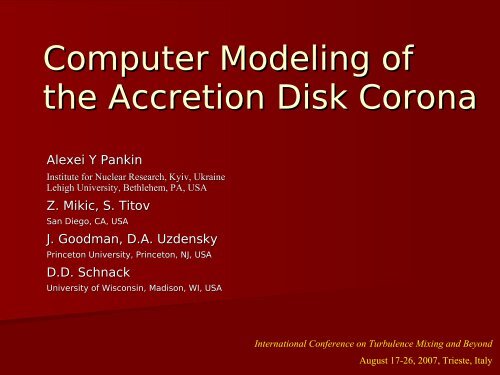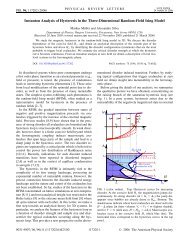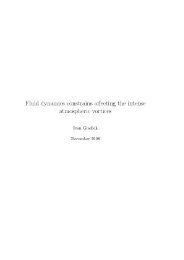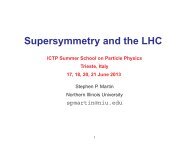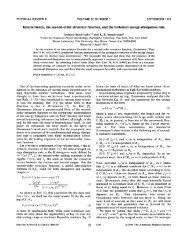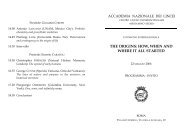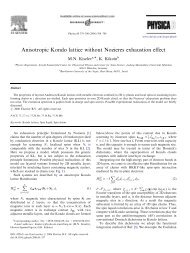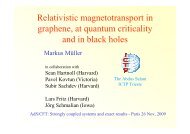Pankin - ICTP
Pankin - ICTP
Pankin - ICTP
Create successful ePaper yourself
Turn your PDF publications into a flip-book with our unique Google optimized e-Paper software.
Computer Modeling of<br />
the Accretion Disk Corona<br />
Alexei Y <strong>Pankin</strong><br />
Institute for Nuclear Research, Kyiv, Ukraine<br />
Lehigh University, Bethlehem, PA, USA<br />
Z. Mikic, S. Titov<br />
San Diego, CA, USA<br />
J. Goodman, D.A. Uzdensky<br />
Princeton University, Princeton, NJ, USA<br />
D.D. Schnack<br />
University of Wisconsin, Madison, WI, USA<br />
International Conference on Turbulence Mixing and Beyond<br />
August 17-26, 2007, Trieste, Italy
Outline<br />
Introduction<br />
Model for coronal accretion disk<br />
Initial state, equilibrium, assumptions<br />
Coupling of accretion disk and corona<br />
Simulation results<br />
Summary<br />
ICTMB, Trieste, Italy, August 2007
Introduction<br />
Accretion disks are unique phenomena that observed<br />
for very different astrophysical objects such as<br />
Protostars<br />
Galactic X-ray binaries<br />
Active galactic nuclei<br />
The problem of formation and dynamics of accretion<br />
disks is closely related to the problem of jet formation<br />
The accretion of matter should be associated with the<br />
release of energy and angular momentum<br />
Energy losses for most astrophysical objects can be<br />
explained by emission of radiation<br />
Angular momentum losses remain an open problem in<br />
astrophysics<br />
ICTMB, Trieste, Italy, August 2007
Models for angular momentum dissipation<br />
There are several models for angular<br />
momentum dissipation in accretion disks:<br />
Dissipation due to viscosity<br />
ICTMB, Trieste, Italy, August 2007
Cataclysmic Variable<br />
T accretion =l 2 / v ≈ 108 2 [m 2 ]<br />
10 [m 2 /sec]<br />
Companion star<br />
=10 15 [sec]≈10 9 [years]<br />
Accretion disk<br />
White dwarf
Models for angular momentum dissipation<br />
There are several models for angular<br />
momentum dissipation in accretion disks:<br />
Dissipation due to viscosity<br />
anisotropic viscosity<br />
Dissipation due to magnetized winds (Blandford &<br />
Payne'82):<br />
ejection of matter that spun up to the velocities that are<br />
grater than the escape velocity<br />
occurs when the projection of gravitational force is not<br />
sufficient to balance the centrifugal force.<br />
Dissipation due to magnetic stresses<br />
Balbus-Hawley ('91) instability (following Velikhov'59<br />
derivations)<br />
ICTMB, Trieste, Italy, August 2007
Conservation of angular momentum<br />
Angular momentum equation<br />
∂<br />
∂t ∫ V r×v⋅z dV =−∫ ∂ V n⋅⋅r * ⋅z dS−∫ v v ∇×v⋅z dV<br />
Stress tensor: =v⊗v− 1<br />
In cylindrical coordinates (r, φ, z)<br />
(disk rotation is around z-axis)<br />
• the microscopic viscosity is too small to sustain the accretion<br />
• a turbulent viscosity ?<br />
• magnetic field helps to make differential-rotation flows unstable<br />
MRI in the disk<br />
coronal MRI<br />
ICTMB, Trieste, Italy, August 2007<br />
4<br />
B⊗B pB2<br />
8 I − ∇ v<br />
v
Coronal Magneto-Rotational Instability (MRI)<br />
Side view<br />
ICTMB, Trieste, Italy, August 2007<br />
Top view<br />
The flux tube stretches <br />
• leading/lower spot loses<br />
to the trailing/upper one,<br />
• the lower spot sinks,<br />
while the upper spot rises;<br />
• the difference in their increases
cont. eq.<br />
induct. eq.<br />
ICTMB, Trieste, Italy, August 2007<br />
Disk<br />
In cylindrical coordinates (r, φ, z), integrated over z<br />
Eqs. of motion<br />
input (from corona)<br />
output (for corona)
ρ <br />
ICTMB, Trieste, Italy, August 2007<br />
Corona<br />
Resistive MHD eqs.<br />
input (from disk)<br />
∇ ×B= 4π<br />
c<br />
J , ∇ ×E=− 1<br />
c<br />
at z = 0<br />
∂ B<br />
∂t<br />
, 5 <br />
E 1<br />
v×B= η J , 6 <br />
c<br />
∂ ρ<br />
∇⋅ ρv =0, 7 <br />
∂t<br />
∂ p<br />
∇⋅pv =−γ−1 p ∇⋅v , 8 <br />
∂t<br />
v<br />
∂ v<br />
1<br />
v⋅∇ = J×B−∇ pρg∇⋅νρ ∇ v , 9 <br />
∂ t c<br />
output (for disk)
Initial Equilibrium State<br />
Axisymmetric disk and corona<br />
Kepler differential flow profile: Ω=Ω 0 (r/r 0 ) –3/2<br />
Self-consistent equilibrium with finite pressure and g appropriate to a central object<br />
(modified to remove singularity)<br />
Isothermal equation of state: γ = 1, p=c s 2 ρ with cs constant<br />
Barotropic equation of state: p = p(ρ)<br />
Bipolar potential magnetic field: J×B=0<br />
The initial B z is chosen to minimize force imbalance when the coupling between the<br />
disk and corona is included<br />
Equilibrium state is found as a balance between pressure, gravity and centrifugal<br />
force<br />
For p = constant at z = 0,<br />
max(M a )=1, max(M b )≡v 0 /v A
Initial Equilibrium State<br />
Linear and angular<br />
velocities<br />
Gravitational<br />
potential<br />
ICTMB, Trieste, Italy, August 2007<br />
Magnetic field bipole with poles at r =<br />
3a and r = 6a<br />
Kepler Flow with Initial Contours of B z
MHD resistive code MAB<br />
3D Cartesian (x,y,z) resistive MHD code<br />
Finite difference mesh, structured, nonuniform<br />
Implicit (semi-implicit waves, fully implicit diffusion)<br />
OpenMP support<br />
Used for solar coronal modeling (magnetic and thermal<br />
structure of active regions)<br />
MAB code has first-order upwind diffusion<br />
Estimated viscosity and resistivity due to upwinding:<br />
ICTMB, Trieste, Italy, August 2007<br />
ηuw ,ν uw ~vΔ x /2
Magnetic torque density<br />
We are interested in the evolution of the<br />
magnetic torque density on the disk:<br />
Eqs. of motion on the disk<br />
ICTMB, Trieste, Italy, August 2007<br />
K =R B B z<br />
2
Simulation results<br />
Evolution of B z at z = 0<br />
Magnetic field lines<br />
Launch point at B z =.5 B zmax<br />
ICTMB, Trieste, Italy, August 2007<br />
Magnetic field lines<br />
Launch point at B z =.75 B zmax<br />
Magnetic field lines<br />
Launch point at B z =.25 B zmax
Evolution of magnetic torque<br />
Projection of this simulation results indicates that there a transport of<br />
angular momentum inward for the inner spot and outward for the outer<br />
spot<br />
ICTMB, Trieste, Italy, August 2007
Deviation from force free conditions<br />
∣J⋅B∣<br />
∣J× B∣<br />
ICTMB, Trieste, Italy, August 2007<br />
∣J⋅B∣ and ∣J× B∣<br />
time
New initial conditions for magnetic perturbations<br />
Disk magnetic flux function:<br />
=sina RtanhbR 4 tanhR 2 tanhR out −R ,<br />
Ψ<br />
where a=4/R out tanhbR out 4 <br />
ICTMB, Trieste, Italy, August 2007<br />
B z
New initial conditions for magnetic dipoles<br />
Disk flux function:<br />
=sina RtanhbR 4 tanhR 2 tanhR out −R ,<br />
Ψ<br />
where a=4/R out tanhbR out 4 <br />
ICTMB, Trieste, Italy, August 2007<br />
B z
Results for multispot case<br />
Bz<br />
Σ<br />
ICTMB, Trieste, Italy, August 2007<br />
Evolution of magnetic torque density
Results for multispot case<br />
Evolution of<br />
magnetic field<br />
lines<br />
ICTMB, Trieste, Italy, August 2007
Summary<br />
Model for accretion disk in solar corona is developed<br />
and implemented in resistive MHD code<br />
Evolution of single and multiple magnetic loops in the<br />
corona driven by Keplerian shear flow in the disk is<br />
reported<br />
There are indications that the evolution of magnetic<br />
loop is associated with reconnection of magnetic<br />
field lines in corona and<br />
produces angular momentum transport towards<br />
the central object for inner spot<br />
ICTMB, Trieste, Italy, August 2007
Simulation results<br />
ICTMB, Trieste, Italy, August 2007


